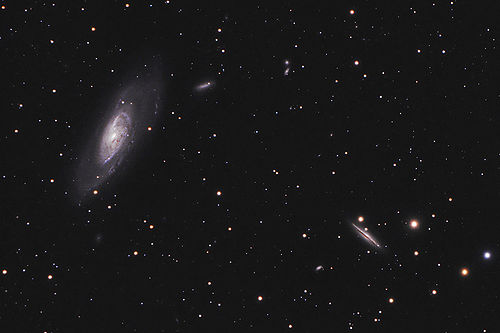
Messier 106
Encyclopedia
Messier 106 is a spiral galaxy
in the constellation
Canes Venatici
. It was discovered by Pierre Méchain
in 1781. M106 is at a distance of about 22 to 25 million light-year
s away from Earth
. It is also a Seyfert II galaxy
, which means that due to x-ray
s and unusual emission lines detected, it is suspected that part of the galaxy is falling into a supermassive black hole
in the center. NGC 4217 is a possible companion galaxy of Messier 106.
that is seen by the 22-GHz line of ortho-H2O that evidences dense and warm molecular gas. Water masers are useful to observe nuclear accretion disks in active galaxies. M106 has a slightly warped, thin, almost edge-on Keplerian disk which is on a subparsec scale. It surrounds a central area with mass four × 107M⊙
.

Spiral galaxy
A spiral galaxy is a certain kind of galaxy originally described by Edwin Hubble in his 1936 work The Realm of the Nebulae and, as such, forms part of the Hubble sequence. Spiral galaxies consist of a flat, rotating disk containing stars, gas and dust, and a central concentration of stars known as...
in the constellation
Constellation
In modern astronomy, a constellation is an internationally defined area of the celestial sphere. These areas are grouped around asterisms, patterns formed by prominent stars within apparent proximity to one another on Earth's night sky....
Canes Venatici
Canes Venatici
Canes Venatici is one of the 88 official modern constellations. It is a small northern constellation that was created by Johannes Hevelius in the 17th century. Its name is Latin for "hunting dogs", and the constellation is often depicted in illustrations as representing the dogs of Boötes the...
. It was discovered by Pierre Méchain
Pierre Méchain
Pierre François André Méchain was a French astronomer and surveyor who, with Charles Messier, was a major contributor to the early study of deep sky objects and comets.-Life:...
in 1781. M106 is at a distance of about 22 to 25 million light-year
Light-year
A light-year, also light year or lightyear is a unit of length, equal to just under 10 trillion kilometres...
s away from Earth
Earth
Earth is the third planet from the Sun, and the densest and fifth-largest of the eight planets in the Solar System. It is also the largest of the Solar System's four terrestrial planets...
. It is also a Seyfert II galaxy
Seyfert galaxy
Seyfert galaxies are a class of galaxies with nuclei that produce spectral line emission from highly ionized gas, named after Carl Keenan Seyfert, the astronomer who first identified the class in 1943...
, which means that due to x-ray
X-ray
X-radiation is a form of electromagnetic radiation. X-rays have a wavelength in the range of 0.01 to 10 nanometers, corresponding to frequencies in the range 30 petahertz to 30 exahertz and energies in the range 120 eV to 120 keV. They are shorter in wavelength than UV rays and longer than gamma...
s and unusual emission lines detected, it is suspected that part of the galaxy is falling into a supermassive black hole
Supermassive black hole
A supermassive black hole is the largest type of black hole in a galaxy, in the order of hundreds of thousands to billions of solar masses. Most, and possibly all galaxies, including the Milky Way, are believed to contain supermassive black holes at their centers.Supermassive black holes have...
in the center. NGC 4217 is a possible companion galaxy of Messier 106.
Characteristics
M106 has a water vapor maserMaser
A maser is a device that produces coherent electromagnetic waves through amplification by stimulated emission. Historically, “maser” derives from the original, upper-case acronym MASER, which stands for "Microwave Amplification by Stimulated Emission of Radiation"...
that is seen by the 22-GHz line of ortho-H2O that evidences dense and warm molecular gas. Water masers are useful to observe nuclear accretion disks in active galaxies. M106 has a slightly warped, thin, almost edge-on Keplerian disk which is on a subparsec scale. It surrounds a central area with mass four × 107M⊙
Solar mass
The solar mass , , is a standard unit of mass in astronomy, used to indicate the masses of other stars and galaxies...
.


